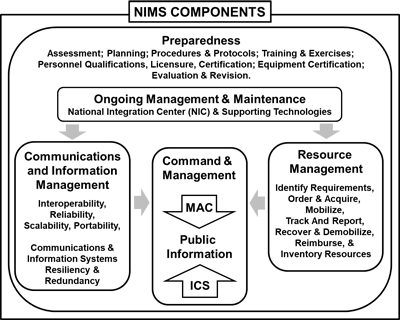The National Incident Management System (NIMS) guides all levels of government, nongovernmental organizations (NGO), and the private sector to work together to prevent, protect against, mitigate, respond to, and recover from incidents. NIMS provides stakeholders across the whole community with the shared vocabulary, systems, and processes to successfully deliver the capabilities described in the National Preparedness System. NIMS defines operational systems, including the Incident Command System (ICS), Emergency Operations Center (EOC) structures, and Multiagency Coordination Groups (MAC Groups) that guide how personnel work together during incidents. NIMS applies to all incidents, from traffic accidents to major disasters.
The National Response Framework (NRF) and National Incident Management System (NIMS) provide framework and function for the concepts, structures, and coordination involved the preparation and coordination of the knowledge, systems, and resources required for all-hazards response.
NRF includes all presidential directives, plans, and programs, associated with disaster response and all support efforts provided by those agencies not directly tied to disaster response, but offering support. NIMS directs and standardizes aspects of coordination and cooperation within and between Federal and Regional response efforts.

NIMS is a consistent, nationwide, systematic approach that includes the following components: preparedness, communications and information management, resource management, command and management, and ongoing management and maintenance.
A basic premise of both NIMS and the NRF is that incidents typically are managed at the Local level first. Following NIMS doctrine, the NRF is designed to ensure that Local jurisdictions retain command, control, and authority over response activities for their jurisdictional areas. Even though each jurisdiction’s integrity is preserved there must still be collaboration. The strength of independence is supported by the capacity for coordinated Unity of Effort.
NIMS provides a consistent nationwide template to enable Federal, State, Tribal, and Local governments, nongovernmental organizations, and the private sector to work together effectively to prevent, protect against, respond to, recover from, and mitigate the effects of incidents regardless of cause, size, location, or complexity in order to reduce the loss of life and property and harm to the environment.
What NIMS Does
In the FEMA course work there is a statement: “What is NIMS?”. For the purposes of definition you are asked to rephrase the question into a statement of fact: What NIMS Does. NIMS is not an “is”. NIMS is methodology. There are very real actions taken and very real connections being made in NIMS, but it all takes place within the existing structure of Government (under NRF) and within the ICS structure.
NIMS is how the plans and preparations of the NRF are expressed, communicated, coordinated, and agreed upon so that the disaster response structure found in ICS can operate smoothly. NIMS consists of the methods used to achieve Unity of Effort. This idea of NIMS method working within NRF and ICS structure is not a simple thing to “see” all at once.
In describing NIMS this discussion shall first examine and expound upon the NIMS concepts. Next it will identify the sole principle of NIMS; the anchor point that makes NIMS work. From there the 5 components (the mandatory methods) will be examined in detail.
NIMS Concepts
The FEMA NIMS course work identifies NIMS concepts as Flexibility, Standardization, and Dynamics. To these FEMA Concepts, this book adds Expectation, Coordination, and Agreement.
NIMS Principle
NIMS has only one Principle: Mandate. Methodology in NIMS is mandated. There is no discussion on, or allowance for, other methodologies. The HSPD-5 makes it crystal clear this is how planning, preparation, and response will be coordinated. Those methods are defined by the 5 NIMS components. NIMS only works if there is standardization in organization and practice in addition to agreement on how response will be conducted.
NIMS Components
The NIMS Components are: Preparedness, Communications and Information Management, Resource Management, Command and Management, and Ongoing Management and Maintenance. These “components” make up the organizational goals of NIMS; not to be confused with operational goals of ICS.
Disaster Response SMARTbook 1 – Federal/National Disaster Response (DRS1) has two full chapters (88 pages) covering the National Incident Management System (NIMS). DRS1 is designed to serve as a comprehensive reference to NRF and NIMS concepts, reference documents, and application; as a pocket reference for experienced responders; or as a desk reference for emergency planners, community leaders, or any responder involved in the process of preparation and coordination of response support and leadership.
 This article is an extract from “Disaster Response SMARTbook 1 – Federal/National Disaster Response” by The Lightning Press. DRS1 provides a detailed explanation of National Response Framework (NRF) and National Incident Management System (NIMS), as well as discussion of the Multiagency Coordination Systems (MACS). Download a free PDF sample and learn more at: Disaster Response SMARTbook 1 – Federal/National Disaster Response.
This article is an extract from “Disaster Response SMARTbook 1 – Federal/National Disaster Response” by The Lightning Press. DRS1 provides a detailed explanation of National Response Framework (NRF) and National Incident Management System (NIMS), as well as discussion of the Multiagency Coordination Systems (MACS). Download a free PDF sample and learn more at: Disaster Response SMARTbook 1 – Federal/National Disaster Response.
Browse additional military doctrine articles in our SMARTnews Blog & Resource Center.
About The Lightning Press SMARTbooks. Recognized as a “whole of government” doctrinal reference standard by military, national security and government professionals around the world, SMARTbooks comprise a comprehensive professional library. SMARTbooks can be used as quick reference guides during operations, as study guides at education and professional development courses, and as lesson plans and checklists in support of training. Browse our collection of Military Reference SMARTbooks to learn more.













































